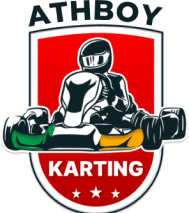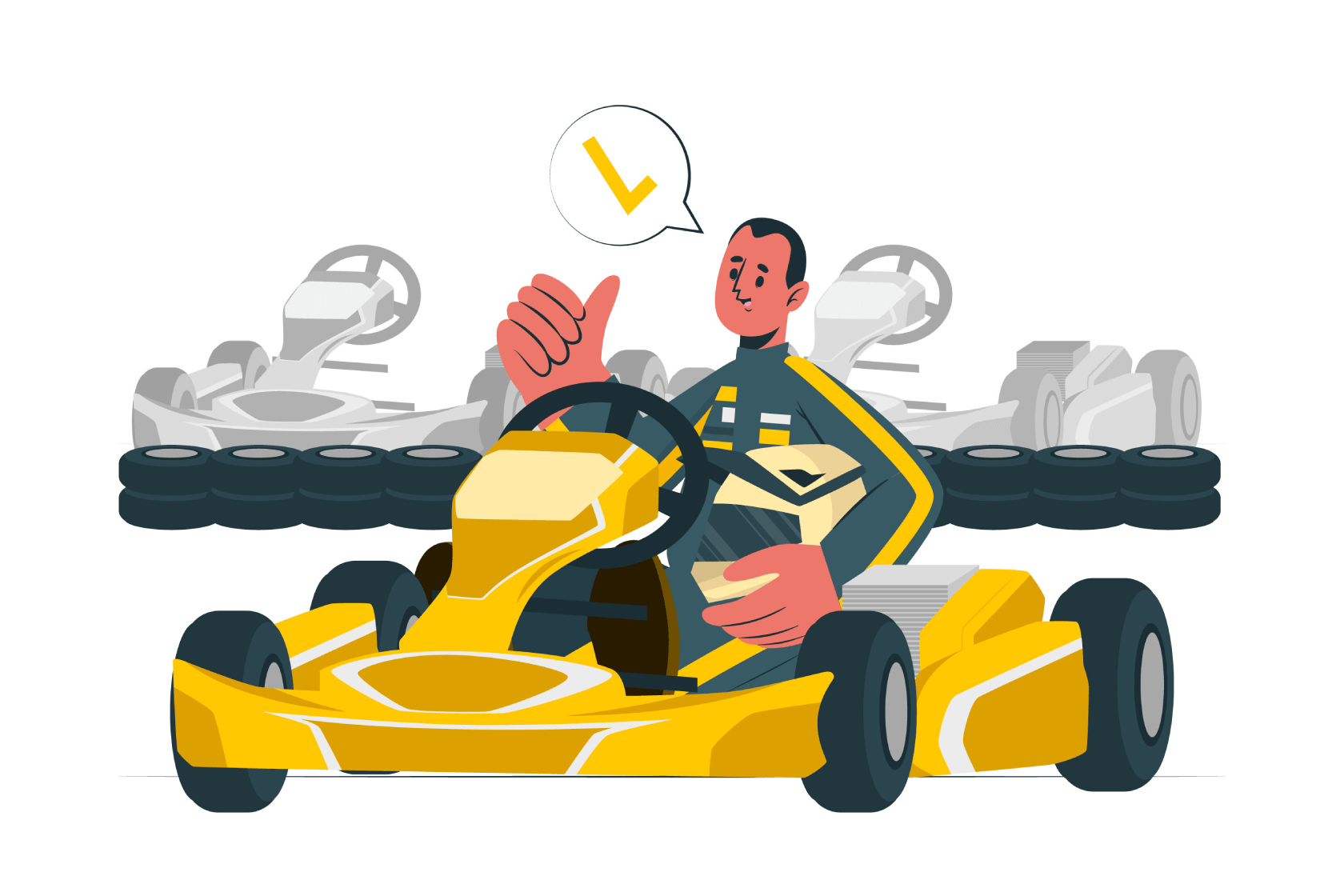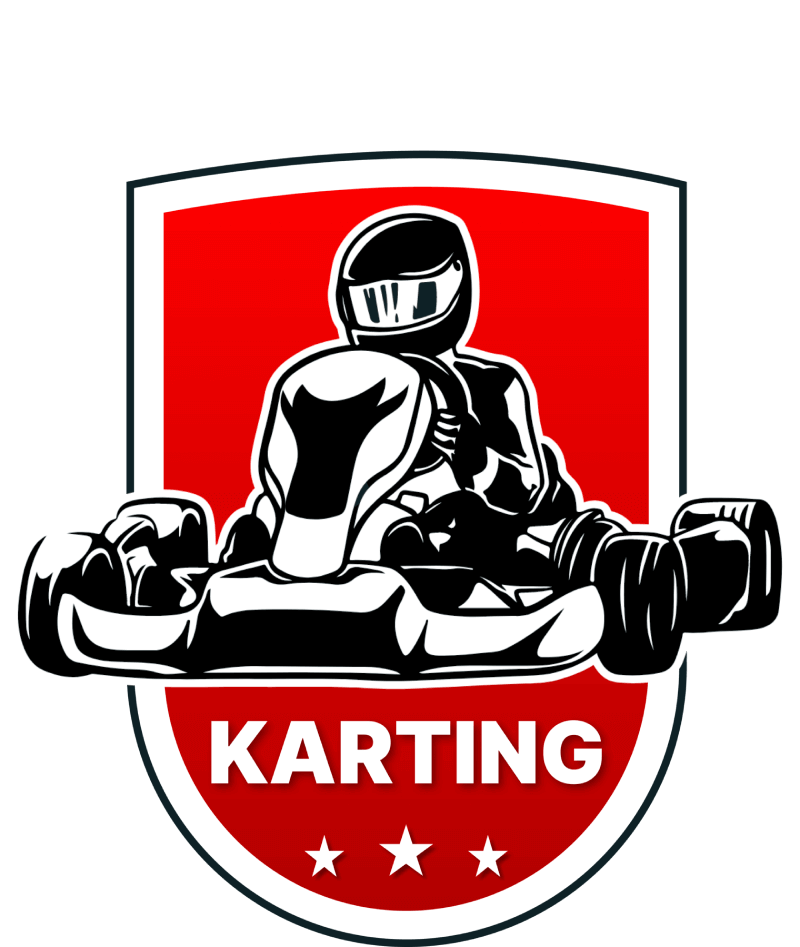All kart units are mounted on a frame welded from strong steel pipes with an outside diameter of 35-40mm. The front steerable wheels are mounted on knuckles. They are connected to the steering wheel by a cross rod and a steering shaft. There is no steering gear (a mechanism that helps to turn the wheels in "big" cars), so the steering stroke is very short, almost like on a bicycle. It takes a lot of effort to turn the wheel and after half an hour of driving inexperienced pilots' hands fall off. Pilot's seat is installed on a frame, so low that a pilot literally scribbles on asphalt. The seat is made strong enough and a sheet of aluminum, fiberglass or thick aircraft plywood is attached under it (at the bottom of the frame), so as to save a "bum".
The motor is placed on the right and slightly behind the seat (most often it is on the right, but on some models on the left or completely behind). A chain or belt drive connects the engine to the rear axle. In the more recent DD 2 (Direct Drive) karts, the motor is mounted on the rear axle and is driven by direct rotation of the axle through a pinion. The rear axle is one piece, unlike a car. A brake disc is mounted on it. The fuel tank is placed under the steering wheel between the pilot's legs on sports go-karts and behind the seat on rental go-karts.
The gear lever is placed to the right of the seat. The pedals were formerly arranged in the same way as on a normal car: the accelerator pedal on the front right and the brake pedal slightly to the left. These pedals were operated with the right foot. The clutch pedal was controlled by the left foot, just as in a grown-up car. A quarter of a century ago, it was replaced by a lever that resembled a motorbike lever and was placed under the steering wheel in front of the left hand.
There's no clutch pedal or gear lever on the right hand side of the kart, but it's not necessary as it's equipped with automatic transmission.
Suspension of karts has no springs and shock absorbers. In fact, there's no suspension at all. Because of this, small cars are very stiff, riding them feels like riding on a stool. That's why karting tracks are trying to be perfectly smooth, removing everything from asphalt, even the smallest bumps.
An important element of karting - wheels. The front ones are always smaller than the rear ones, both in width and diameter. Rear ones, on the contrary, are more massive and wide. It's understandable: the main weight of the car and the pilot falls on the rear axle. Rear wheels accelerate a cart, they also brake it (there are no brakes on front wheels on many sport models). By the way, tyres for karts, as well as for large racing cars, are made for dry surface, and for rain rubber of special compound, which literally sticks to the track and allows you to go through the turns very quickly.
More for the curious
"THE CLEVER SPROCKET.
Kart speed is a function of engine power and rpm. The more powerful the engine, the faster the kart accelerates; the higher the speed, the higher the top speed can be. But it's not just these parameters that determine how fast a kart can go. A reminder: the engine and the rear axle (i.e. the wheels) are connected by a chain gear. The sprocket that is in the engine (called the master sprocket) always has 10 teeth; the sprockets on the rear axle (the idler sprockets) can be 80 to 83. The more teeth on the sprocket, the better the kart accelerates from a standstill or gains low to medium speed. On the other hand, the smaller the sprocket, the higher the top speed.
The sprockets change depending on how difficult the course is. If the track is full of sharp corners and steep climbs, a bigger sprocket is best (if you are heavy, by the way). On tracks with long flat sections and smooth corners, it's better to use a fast sprocket.
The motor is placed on the right and slightly behind the seat (most often it is on the right, but on some models on the left or completely behind). A chain or belt drive connects the engine to the rear axle. In the more recent DD 2 (Direct Drive) karts, the motor is mounted on the rear axle and is driven by direct rotation of the axle through a pinion. The rear axle is one piece, unlike a car. A brake disc is mounted on it. The fuel tank is placed under the steering wheel between the pilot's legs on sports go-karts and behind the seat on rental go-karts.
The gear lever is placed to the right of the seat. The pedals were formerly arranged in the same way as on a normal car: the accelerator pedal on the front right and the brake pedal slightly to the left. These pedals were operated with the right foot. The clutch pedal was controlled by the left foot, just as in a grown-up car. A quarter of a century ago, it was replaced by a lever that resembled a motorbike lever and was placed under the steering wheel in front of the left hand.
There's no clutch pedal or gear lever on the right hand side of the kart, but it's not necessary as it's equipped with automatic transmission.
Suspension of karts has no springs and shock absorbers. In fact, there's no suspension at all. Because of this, small cars are very stiff, riding them feels like riding on a stool. That's why karting tracks are trying to be perfectly smooth, removing everything from asphalt, even the smallest bumps.
An important element of karting - wheels. The front ones are always smaller than the rear ones, both in width and diameter. Rear ones, on the contrary, are more massive and wide. It's understandable: the main weight of the car and the pilot falls on the rear axle. Rear wheels accelerate a cart, they also brake it (there are no brakes on front wheels on many sport models). By the way, tyres for karts, as well as for large racing cars, are made for dry surface, and for rain rubber of special compound, which literally sticks to the track and allows you to go through the turns very quickly.
More for the curious
"THE CLEVER SPROCKET.
Kart speed is a function of engine power and rpm. The more powerful the engine, the faster the kart accelerates; the higher the speed, the higher the top speed can be. But it's not just these parameters that determine how fast a kart can go. A reminder: the engine and the rear axle (i.e. the wheels) are connected by a chain gear. The sprocket that is in the engine (called the master sprocket) always has 10 teeth; the sprockets on the rear axle (the idler sprockets) can be 80 to 83. The more teeth on the sprocket, the better the kart accelerates from a standstill or gains low to medium speed. On the other hand, the smaller the sprocket, the higher the top speed.
The sprockets change depending on how difficult the course is. If the track is full of sharp corners and steep climbs, a bigger sprocket is best (if you are heavy, by the way). On tracks with long flat sections and smooth corners, it's better to use a fast sprocket.







